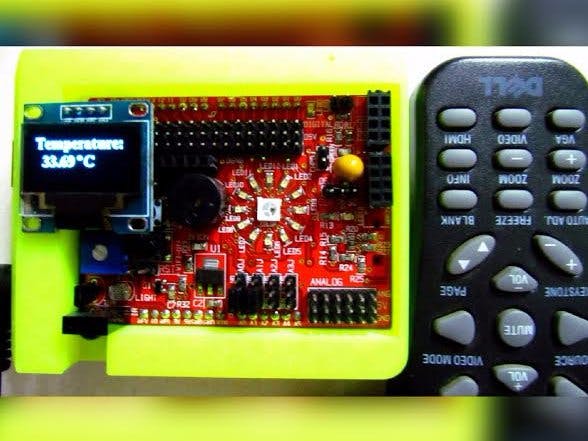#include <Adafruit_NeoPixel.h>
#include <IRremote.h>
#include "U8glib.h"
int RECV_PIN = 3;
IRrecv irrecv(RECV_PIN);
decode_results results;
#define PIN 6
float tempInC;
int wait= 1;
#define time 10
int freq;
int counter;
bool test1=true;
bool test2=false;
bool test3=false;
bool test4=false;
bool test5=false;
Adafruit_NeoPixel strip = Adafruit_NeoPixel(1, PIN, NEO_GRB + NEO_KHZ800);
U8GLIB_SSD1306_128X64 u8g(U8G_I2C_OPT_DEV_0|U8G_I2C_OPT_NO_ACK|U8G_I2C_OPT_FAST); // Fast I2C / TWI
void setup()
{
irrecv.enableIRIn(); // Start the receiver
strip.begin();
strip.show(); // Initialize all pixels to 'off'
u8g.setFont(u8g_font_timB14);
}
void loop()
{
if (irrecv.decode(&results) && test1 == true)
{
delay(500);
counter+=1;
u8g.firstPage();
do
{
u8g.drawStr(20,20,"Multicolor");
u8g.drawStr(15,45,"Led Effects");
} while( u8g.nextPage() );
irrecv.resume(); // Receive the next value
test1=false; test2=true;
colorWipe(strip.Color(255, 0, 0), 1500); // Red
colorWipe(strip.Color(0, 255, 0), 1500); // Green
colorWipe(strip.Color(0, 0, 255), 1500); // Blue
// FadeInFadeOut();
rainbow(20);
fadeInFadeOut();
colorWipe(strip.Color(0, 0, 0), 250); // Blue
}
delay(100);
if (irrecv.decode(&results) && test2 == true)
{
delay(500);
counter+=1;
u8g.firstPage();
do
{
u8g.drawStr(0,20,"Happy Birthday");
u8g.drawStr(30,45,"Melody");
} while( u8g.nextPage() );
irrecv.resume(); // Receive the next value
test3=false;test3=true;
happy_birthday();
}
delay(100);
if (irrecv.decode(&results) && test3 == true)
{
delay(500);
counter+=1;
irrecv.resume(); // Receive the next value
test4=false;test4=true;
u8g.firstPage();
do
{
u8g.drawStr(0,20,"Police Siren");
} while( u8g.nextPage() );
police_Siren();
colorWipe(strip.Color(0, 0, 0), 250); // Blue
}
if (irrecv.decode(&results) && test4 == true)
{
delay(500);
counter+=1;
irrecv.resume(); // Receive the next value}
}
if(counter == 4 && test4 == true)
{
int val1 = analogRead(A0);
int val = analogRead(A0);
float voltage = val * (5000.0 / 1024.0); // voltage at pin milliVolts
tempInC = (voltage / 10); // voltage to C
temperature();
delay(500);
// }
if (irrecv.decode(&results))
{
counter=0;
test4=false;test1=true;
}
delay(100);
}
}
// Fill the dots one after the other with a color
void colorWipe(uint32_t c, uint8_t wait)
{
for(uint16_t i=0; i<strip.numPixels(); i++)
{
strip.setPixelColor(i, c);
strip.show();
delay(wait);
}
}
void rainbow(uint8_t wait)
{
uint16_t i, j;
for(j=0; j<256; j++)
{
for(i=0; i<strip.numPixels(); i++)
{
strip.setPixelColor(i, Wheel((i+j) & 255));
}
strip.show();
delay(wait);
}
}
// Input a value 0 to 255 to get a color value.
// The colours are a transition r - g - b - back to r.
uint32_t Wheel(byte WheelPos)
{
if(WheelPos < 85)
{
return strip.Color(WheelPos * 3, 255 - WheelPos * 3, 0);
}
else if(WheelPos < 170)
{
WheelPos -= 85;
return strip.Color(255 - WheelPos * 3, 0, WheelPos * 3);
}
else
{
WheelPos -= 170;
return strip.Color(0, WheelPos * 3, 255 - WheelPos * 3);
}
}
void fadeInFadeOut()
{
for(int j = 0; j < 3; j++ )
{
// Fade IN
for(int k = 0; k < 256; k++)
{
switch(j)
{
case 0: colorWipe(strip.Color(k,0,0),1); break;
case 1: colorWipe(strip.Color(0,k,0),1); break;
case 2: colorWipe(strip.Color(0,0,k),1); break;
}
delay(10);
}
// Fade OUT
for(int k = 255; k >= 0; k--)
{
switch(j)
{
case 0: colorWipe(strip.Color(k,0,0),1); break;
case 1: colorWipe(strip.Color(0,k,0),1); break;
case 2: colorWipe(strip.Color(0,0,k),1); break;
}
delay(10);
}
}
}
void happy_birthday()
{
// notes in the melody:
int melody[]= { 196, 196, 220, 196, 512, 247,
196,196, 220,196, 294, 512,
196, 196, 392,330,512, 247, 220,
349, 349, 330, 512, 294, 512 };
// note durations: 4 = quarter note, 8 = eighth note, etc.:
int noteDurations[] = { 8,8,4,4,4,2,8,8,4,4,4,2,8,8,4,4,4,4,3,8,8,4,4,4,2 };
// iterate over the notes of the melody:
for (int thisNote = 0; thisNote < 26; thisNote++)
{
// to calculate the note duration, take one second
// divided by the note type.
//e.g. quarter note = 1000 / 4, eighth note = 1000/8, etc.
int noteDuration = 1000/noteDurations[thisNote];
tone(A1, melody[thisNote],noteDuration);
// to distinguish the notes, set a minimum time between them.
// the note's duration + 30% seems to work well:
int pauseBetweenNotes = noteDuration * 1.60;
delay(pauseBetweenNotes);
// stop the tone playing:
noTone(8);
}
}
float temperature()
{
// return degreesC;
u8g.firstPage();
do
{
u8g.drawStr(5,20,"Temperature:");
//u8g.setFont(u8g_font_timB18);
u8g.setPrintPos(15, 42);
u8g.print(tempInC );
u8g.setPrintPos(59, 42);
u8g.print(char(176));
u8g.setPrintPos(67, 42);
u8g.print("C");
} while( u8g.nextPage() );
// rebuild the picture after some delay
// delay(50);
}
void police_Siren()
{
for(freq = 150; freq < 1800; freq += 1)
{
colorWipe(strip.Color(0,0,freq),1);
//color(0,0,freq);
tone(A1, freq, time); // Beep pin, freq, time
delay(wait);
}
for(freq = 1800; freq > 150; freq -= 1)
{
colorWipe(strip.Color(freq,0,0),1);
//color(freq,0,0);
tone(A1, freq, time); // Beep pin, freq, time
delay(wait);
}
}
#include <Adafruit_NeoPixel.h>
#include <IRremote.h>
#include "U8glib.h"
int RECV_PIN = 3;
IRrecv irrecv(RECV_PIN);
decode_results results;
#define PIN 6
float tempInC;
int wait= 1;
#define time 10
int freq;
int counter;
bool test1=true;
bool test2=false;
bool test3=false;
bool test4=false;
bool test5=false;
Adafruit_NeoPixel strip = Adafruit_NeoPixel(1, PIN, NEO_GRB + NEO_KHZ800);
U8GLIB_SSD1306_128X64 u8g(U8G_I2C_OPT_DEV_0|U8G_I2C_OPT_NO_ACK|U8G_I2C_OPT_FAST); // Fast I2C / TWI
void setup()
{
irrecv.enableIRIn(); // Start the receiver
strip.begin();
strip.show(); // Initialize all pixels to 'off'
u8g.setFont(u8g_font_timB14);
}
void loop()
{
if (irrecv.decode(&results) && test1 == true)
{
delay(500);
counter+=1;
u8g.firstPage();
do
{
u8g.drawStr(20,20,"Multicolor");
u8g.drawStr(15,45,"Led Effects");
} while( u8g.nextPage() );
irrecv.resume(); // Receive the next value
test1=false; test2=true;
colorWipe(strip.Color(255, 0, 0), 1500); // Red
colorWipe(strip.Color(0, 255, 0), 1500); // Green
colorWipe(strip.Color(0, 0, 255), 1500); // Blue
// FadeInFadeOut();
rainbow(20);
fadeInFadeOut();
colorWipe(strip.Color(0, 0, 0), 250); // Blue
}
delay(100);
if (irrecv.decode(&results) && test2 == true)
{
delay(500);
counter+=1;
u8g.firstPage();
do
{
u8g.drawStr(0,20,"Happy Birthday");
u8g.drawStr(30,45,"Melody");
} while( u8g.nextPage() );
irrecv.resume(); // Receive the next value
test3=false;test3=true;
happy_birthday();
}
delay(100);
if (irrecv.decode(&results) && test3 == true)
{
delay(500);
counter+=1;
irrecv.resume(); // Receive the next value
test4=false;test4=true;
u8g.firstPage();
do
{
u8g.drawStr(0,20,"Police Siren");
} while( u8g.nextPage() );
police_Siren();
colorWipe(strip.Color(0, 0, 0), 250); // Blue
}
if (irrecv.decode(&results) && test4 == true)
{
delay(500);
counter+=1;
irrecv.resume(); // Receive the next value}
}
if(counter == 4 && test4 == true)
{
int val1 = analogRead(A0);
int val = analogRead(A0);
float voltage = val * (5000.0 / 1024.0); // voltage at pin milliVolts
tempInC = (voltage / 10); // voltage to C
temperature();
delay(500);
// }
if (irrecv.decode(&results))
{
counter=0;
test4=false;test1=true;
}
delay(100);
}
}
// Fill the dots one after the other with a color
void colorWipe(uint32_t c, uint8_t wait)
{
for(uint16_t i=0; i<strip.numPixels(); i++)
{
strip.setPixelColor(i, c);
strip.show();
delay(wait);
}
}
void rainbow(uint8_t wait)
{
uint16_t i, j;
for(j=0; j<256; j++)
{
for(i=0; i<strip.numPixels(); i++)
{
strip.setPixelColor(i, Wheel((i+j) & 255));
}
strip.show();
delay(wait);
}
}
// Input a value 0 to 255 to get a color value.
// The colours are a transition r - g - b - back to r.
uint32_t Wheel(byte WheelPos)
{
if(WheelPos < 85)
{
return strip.Color(WheelPos * 3, 255 - WheelPos * 3, 0);
}
else if(WheelPos < 170)
{
WheelPos -= 85;
return strip.Color(255 - WheelPos * 3, 0, WheelPos * 3);
}
else
{
WheelPos -= 170;
return strip.Color(0, WheelPos * 3, 255 - WheelPos * 3);
}
}
void fadeInFadeOut()
{
for(int j = 0; j < 3; j++ )
{
// Fade IN
for(int k = 0; k < 256; k++)
{
switch(j)
{
case 0: colorWipe(strip.Color(k,0,0),1); break;
case 1: colorWipe(strip.Color(0,k,0),1); break;
case 2: colorWipe(strip.Color(0,0,k),1); break;
}
delay(10);
}
// Fade OUT
for(int k = 255; k >= 0; k--)
{
switch(j)
{
case 0: colorWipe(strip.Color(k,0,0),1); break;
case 1: colorWipe(strip.Color(0,k,0),1); break;
case 2: colorWipe(strip.Color(0,0,k),1); break;
}
delay(10);
}
}
}
void happy_birthday()
{
// notes in the melody:
int melody[]= { 196, 196, 220, 196, 512, 247,
196,196, 220,196, 294, 512,
196, 196, 392,330,512, 247, 220,
349, 349, 330, 512, 294, 512 };
// note durations: 4 = quarter note, 8 = eighth note, etc.:
int noteDurations[] = { 8,8,4,4,4,2,8,8,4,4,4,2,8,8,4,4,4,4,3,8,8,4,4,4,2 };
// iterate over the notes of the melody:
for (int thisNote = 0; thisNote < 26; thisNote++)
{
// to calculate the note duration, take one second
// divided by the note type.
//e.g. quarter note = 1000 / 4, eighth note = 1000/8, etc.
int noteDuration = 1000/noteDurations[thisNote];
tone(A1, melody[thisNote],noteDuration);
// to distinguish the notes, set a minimum time between them.
// the note's duration + 30% seems to work well:
int pauseBetweenNotes = noteDuration * 1.60;
delay(pauseBetweenNotes);
// stop the tone playing:
noTone(8);
}
}
float temperature()
{
// return degreesC;
u8g.firstPage();
do
{
u8g.drawStr(5,20,"Temperature:");
//u8g.setFont(u8g_font_timB18);
u8g.setPrintPos(15, 42);
u8g.print(tempInC );
u8g.setPrintPos(59, 42);
u8g.print(char(176));
u8g.setPrintPos(67, 42);
u8g.print("C");
} while( u8g.nextPage() );
// rebuild the picture after some delay
// delay(50);
}
void police_Siren()
{
for(freq = 150; freq < 1800; freq += 1)
{
colorWipe(strip.Color(0,0,freq),1);
//color(0,0,freq);
tone(A1, freq, time); // Beep pin, freq, time
delay(wait);
}
for(freq = 1800; freq > 150; freq -= 1)
{
colorWipe(strip.Color(freq,0,0),1);
//color(freq,0,0);
tone(A1, freq, time); // Beep pin, freq, time
delay(wait);
}
}
_ztBMuBhMHo.jpg?auto=compress%2Cformat&w=48&h=48&fit=fill&bg=ffffff)














Comments